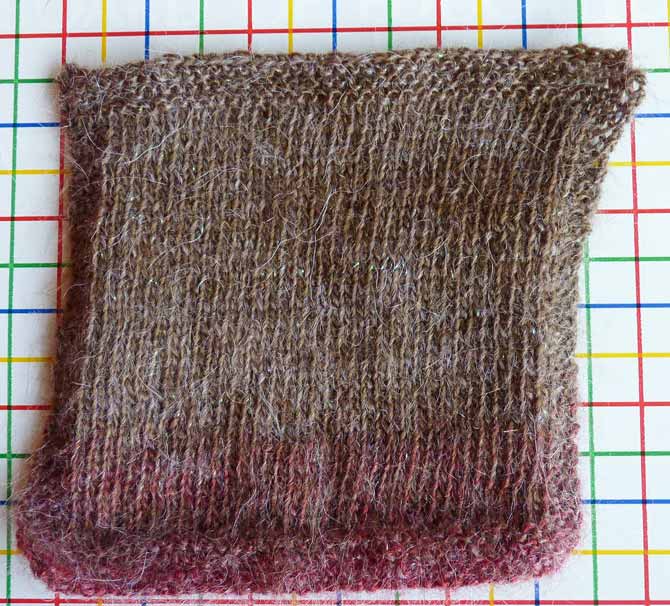Yesterday, I introduced the new Alpaculence, an acrylic/ wool/ alpaca/ glitter blend yarn by Rozetti Yarns.

This week’s featured yarn, Alpaculence, in the agate colorway
Having evaluated the qualities and taken an “inventory” of this yarn, let’s move on to my next step in “new yarn evaluation” – swatching.
When approaching a new yarn, once I’ve held it and evaluated it, I grab the recommended needles on the ball band (in this case, size 4 [3.5mm]) and cast on at least 6″ worth of stitches. Alpaculence has a listed gauge of 27 stitches to 4″ [10cm], so I added another 15 stitches and cast on 42.
I usually knit 4 or 5 ridges of garter stitch, just to help the knitting lay flat, but I skimped out and only did 3, and 3 garter stitches on each side of the work.
Now, I did mention yesterday that I’m biased about a singles yarn. Oh, they have their place, but often this can happen:

My Alpaculence skewed! Oh no! Why did this happen? How can I fix it?
What just happened? The short answer is that I’m knitting with a singles yarn. I have had a similar result with a two- or three-ply yarn, too, but for me, it happens most often with a singles yarn. Whenever this happens, the yarn is telling the knitter that it is out of balance.
Not every singles yarn will skew; some knit up quite straight in stockinette stitch. As I mentioned yesterday, my sample of Alpaculence is pre-production. By the time it gets to market, some of the challenges I’m experiencing will have been corrected.

This plied yarn that I reviewed in 2008 skewed, too, interestingly in the opposite direction to my Alpaculence sample
How can you be sure if your yarn is in or out of balance? Take a couple of arm lengths (generous ones) and fold the strand in half. Let go of the loop end. Does it twirl? Yes? Then it’s likely out of balance. This test can give you a “false reading”, but, if your knitted sample takes off as the ones pictured above, and your twirl test also tells a tale, you pretty much have your second opinion.

To check if your yarn is in balance, do the “twist test” described above. If your result looks like this, you have an unbalanced yarn!
The long answer to my question, “What just happened?” is this:
When yarn is spun and plied, the goal is to have the twist put into the singles balanced out in the plying. The problem is that a singles yarn doesn’t go through the plying process. Sometimes, that means that the finished yarn is “high energy.” (Hence, the twirling mentioned above.)
Remember spinning around on the swing when you were a kid? The physics of that action is this: when you turn the chains or ropes around one another, you put energy into them. When you let go, that energy has to go somewhere.
It’s the same thing with yarn. When the fibers are brushed out and spun together, energy is put into the strand of yarn (the single). Plying two or more singles allows some of that energy to disburse, and ideally, create a balanced yarn. Singles yarn, though, doesn’t go through a plying process. Sometimes the twist can be “set” or “blocked” to cancel out some of the energy, but some fibers (many synthetics) are less responsive to such persuasion.
So what’s a knitter to do? Well, first, recognize that an unbalanced yarn is not at all the end of the world – it just means a little strategy is in order.
I’ve learned a couple of things over the years (wink), and a bit more experimentation is in order. Come back tomorrow for my post “What to do when your yarn goes askew.”
This is part 2 of 5 in this series.
Go back to part 1: Evaluating the very NEW Alpaculence yarn by Rozetti Yarns
Go to part 3: What to do when your yarn goes askew

2 comments
Thank you so much! I´ve bee knitting with a yarn that does this, and it was driving me crazy! Now I know what was happening, my yarn was unbalanced!
Well, I’m really pleased that I was able to explain what was happening and hope my solutions work for you!